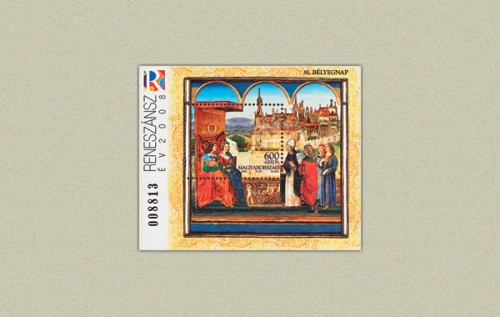
1. MAGYAR - BÉLYEGNAP 81. - BLOKK - Bélyeg rendelési kód: 2008 év bélyegei kompletten
2. ENGLISH - 81. STAMPS DAY - BLOCK - Order code of the stamp: 2008 Year stamps complete
3. GERMAN - Stamp 81. - BLOCK - Die Bestellnummer Der Marke: 2008 Jahr Briefmarken komplett
1. MAGYAR - BÉLYEGNAP 81. - BLOKK
A Magyar Posta a hagyományokhoz híven feláras blokk és két címletből álló sorozat kibocsátásával köszönti a bélyeggyűjtők ünnepét, a 81. Bélyegnapot és a hozzá tartozó bélyegkiállítást, melynek 2008. május 16-18. között a Magyar Bélyeggyűjtők Országos Szövetségének székháza ad otthont.
Rendhagyó módon a 2008. évi ünnepi bélyegek már a Bélyegnapot megelőzően, az Országos Széchényi Könyvtár Csillag a holló árnyékában – Vitéz János és a magyarországi humanizmus kezdetei című kiállítás megnyitójának keretében jelennek meg.
Hunyadi Mátyás magyar király (1443-1490), nevezik Corvin Mátyásnak, az igazságos Mátyás királynak is, hivatalosan I. Mátyásnak, de a köznyelv egyszerűen, mint Mátyás király emlegeti. Magyarországon 1458 és 1490 között uralkodott. A magyar hagyomány az egyik legnagyobb magyar királyként tartja számon, akinek emlékét sok népmese és monda is őrzi. Uralkodása idején budai, illetve visegrádi udvara az európai reneszánsz egyik központjává vált.
A bélyegújdonságok a Corvinák miniatúráinak stílusát idézik, és szerepel rajtuk a Reneszánsz év logója is. A sorszámozott blokkon a trónuson ülő Mátyás király és Beatrix királyné fogadja a pápai követet, a háttérben a Budai vár látható.
Megjelenési időpont: 2008. március 13.
Forrás: Philatelia Hungarica Kft., Magyar Posta
2. ENGLISH - 81. STAMPS DAY - BLOCK
The tradition of the Hungarian Post Office block, and two additional charges by issuing a series denominations welcomed the stamp festival, 81 Stamp and its bélyegkiállítást whose 2008th május 16-18. stamp of the Hungarian National Association hosts the headquarters.
An irregular manner, the 2008th Stamps Stamps is the annual celebration before Stars of the National Library of the raven shadow - Sir John, and the beginnings of humanism in Hungary are under the opening of the exhibition.
Hungarian King Matthias Corvinus (1443-1490), known as Matthias Corvinus, King Matthias, the fair also, I officially Matyas, but in the vernacular, just as King Matthias mentions. Hungary between 1458 and 1490 prevailed. In the Hungarian tradition considers it to one of the greatest Hungarian king, whose memory is preserved in many folk tales and legends. During the reign of Buda and Visegrad courtyard became the center of one of the European Renaissance.
Bélyegújdonságok the style of the Corvin miniatúráinak and bear logo on the Renaissance years. The numbered blocks sitting on the throne of King Matthias and Queen Beatrix receives the papal envoy, the Buda Castle visible in the background.
Date of issue: 13 March 2008
3. GERMAN - Ostern 2008
Die Tradition der ungarischen Post-Block, und zwei zusätzlichen Kosten durch die Herausgabe einer Reihe Konfessionen begrüßt den Stempel Festival 81 Briefmarken und seine bélyegkiállítást deren 2008. május 16-18. Stempel des ungarischen National Association Gastgeber der Zentrale.
Eine unregelmäßige Art und Weise, die 2008. Briefmarken Briefmarken ist die jährliche Feier vor Stars of the National Library of the raven Schatten - Sir John und die Anfänge des Humanismus in Ungarn sind im Rahmen der Eröffnung der Ausstellung.
Ungarischen Königs Matthias Corvinus (1443-1490), bekannt als Matthias Corvinus, König Matthias, der Messe auch ich offiziell Matyas, sondern in der Volkssprache, wie König Matthias erwähnt. Ungarn zwischen 1458 und 1490 herrschte. In der ungarischen Tradition hält es für eines der größten ungarischen König, dessen Andenken wird in vielen Märchen und Legenden erhalten. Während der Herrschaft von Buda und Visegrad-Hof wurde zum Zentrum einer der europäischen Renaissance.
Bélyegújdonságok Stil der Corvin miniatúráinak und Bär-Logo auf der Renaissance-Jahre. Die nummerierten Blöcke auf dem Thron von König Matthias und Königin Beatrix empfängt die päpstlichen Gesandten, die Budaer Burg im Hintergrund sichtbar.










